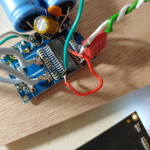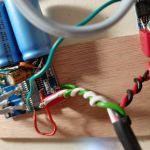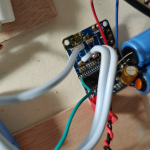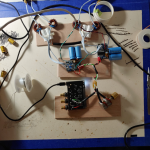useless ,or to be more correct its a minor sonic update ,you must go first for the input capacitors,then output inductors(geting very hot at full power) and output caps
dc input caps are 4x100μF so one piece of 470 or 1000μF is enough!
you dont need to make gremlins!
you dont need to make gremlins!
useless ,or to be more correct its a minor sonic update ,you must go first for the input capacitors,then output inductors(geting very hot at full power) and output caps
The output inductors are what I'm referring to-- I mistyped should have been 22uh-- seems to be a LC Band-pass Limiter with the 680n caps you can see in my pic that are perched over the inductors.
I have some 470nf Clarity Caps that I can prob salvage for C7 and C8 in the attached schematic.
In the past I've noticed some dramatic changes in adding Capacitance on the DC rail. Sometimes just a big ole 6800 works best, sometimes not. I used what's on hand. I want to add a linear regulator at some point (read abraxalitos(Sp?) toying with that earlier in the thread and the idea had crossed my mind.
So yeah still interested in any inductor type/source recommendations.
Attachments
Makes me want to resurrect my 8932 amps. I bought 5 or 6 of them for like £2 each. Crazy.
I have a pair of Salas L adaptors doing nothing and thought I could use one each per channel. Might be interesting.
I have a pair of Salas L adaptors doing nothing and thought I could use one each per channel. Might be interesting.
In the past I've noticed some dramatic changes in adding Capacitance on the DC rail. Sometimes just a big ole 6800 works best, sometimes not. I used what's on hand. I want to add a linear regulator at some point (read abraxalitos(Sp?) toying with that earlier in the thread and the idea had crossed my mind.
The rail that makes the biggest difference is the one on pin8.
So yeah still interested in any inductor type/source recommendations.
I wound my own air-cored inductors on some PQ35 bobbins as an experiment. I could look back at my notebook to see if I recorded the number of turns I used. I didn't notice any subjective improvement over ferrite cored inductors though.
The rail that makes the biggest difference is the one on pin8.
That's what I figured and am concentrating on.
I wound my own air-cored inductors on some PQ35 bobbins as an experiment. I could look back at my notebook to see if I recorded the number of turns I used. I didn't notice any subjective improvement over ferrite cored inductors though.
I appreciate that you would do that but seems unnecessary. I'm pretty damn pleased with the sound as it is so far. This thread has been a great resource.
I had guessed that it would be unnecessary but didn't know for sure without doing the experiment and listening.
I got a couple of those "35W" TDA8932 mono boards, used 2 pcs for stereo. Found that they produce high pitch noise.
I tried a few things:
Seperate power for each module: No change
Add resistor at input: Reduce only overall noise, but high pitch noise remained as loud.
Any idea what may be the problem?
Yes, finally. I've been tinkering with these quite a bit and you'll find in the data sheet (section 8.3) that you need to sync the clocks. I was pulling my hair out trying to get rid of high frequency noise that I thought was a bad cap, PS, EMI, tried everything before reading the instructions. As one does.
As you can see in the pics-- don't judge these are my scrap/test boards-- shorting OSCREF with Vssd (pins 10 and 32) makes one board the SLAVE board, then connecting OSCIO (pins 31) between the two syncs the carrier frequency which can be adjusted with a >25kR but I did no such adjustment and...
VOILA! All high pitch noise gone! They sound, frankly, amazing. That's subjective though. But this should fix your issue.
Attachments
i got around to rewiring these today and it works.
i didn't think it worked at first but my 19v power supply has a whine to it aswell. but on 12v silent when paused.
thanks for the help.
i didn't think it worked at first but my 19v power supply has a whine to it aswell. but on 12v silent when paused.
thanks for the help.
I did the gain mod to my TPA3118 to bring it down from 32db to 26db and it helped a lot with the hiss, to the point I cannot hear it anymore from my listening position. I like the sound I get with my TDA8932 better but I find its hissing much more distracting than what I get with the TPA3118.
For those who tried the gain mod on the TDA8932, does it have any effect on the hiss?
I'm really trying to make this great amp work, I appreciate any insights on reducing its noises... Thanks!
For those who tried the gain mod on the TDA8932, does it have any effect on the hiss?
I'm really trying to make this great amp work, I appreciate any insights on reducing its noises... Thanks!
I have a Dayton DA30 with the TDA8932T chip. On its preamp board there's an auto-on feature but it doesn't work well at low volume - it just doesn't turn on or will suddenly turn off later because the audio volume/voltage is too low or on the borderline. Does anyone know which component(s) on the pre-amp board to modify to make this DA30 always on? Thanks.
Booming out at full volume with no control, immediately on power-on there's a message blasts out about bluetooth enable. Dont use this thing at night, it`'ll wake the whole house!
I'm really trying to make this great amp work, I appreciate any insights on reducing its noises... Thanks!
TDA8932 doesn't have adjustable gain like the TI chips do. If you use it SE then gain is fixed at 30dB, for BTL its 36dB which is way too high. But BTL sounds great and no hiss problem that I can discern if you use a transformer to reduce the gain.
You can use one available on Aliexpress as a step-down : 20Hz 20KHz Permalloy 600Ω 15K 20K and 20K 600Ω audio signal boost transformer voltage reducing transformer DC1000V|Transformers| - AliExpress
hiss from amp
....so you pay over €20 for a traffo to eliminate hiss effect from an amp that costs under €4. Get yourself another amp
TDA8932 doesn't have adjustable gain like the TI chips do. If you use it SE then gain is fixed at 30dB, for BTL its 36dB which is way too high. But BTL sounds great and no hiss problem that I can discern if you use a transformer to reduce the gain.
You can use one available on Aliexpress as a step-down : 20Hz 20KHz Permalloy 600Ω 15K 20K and 20K 600Ω audio signal boost transformer voltage reducing transformer DC1000V|Transformers| - AliExpress
....so you pay over €20 for a traffo to eliminate hiss effect from an amp that costs under €4. Get yourself another amp
....so you pay over €20 for a traffo to eliminate hiss effect from an amp that costs under €4. Get yourself another amp
A while ago I've bought 50 chinese audio transformers 600 Ohm 1:1 but with middle tap for ~4 bucks. A lot more than actually needed for matching. Just look a while at ebay for some bargain, save a search and wait for it.
Help with modding Sawna Board
hi out there
i cannot exchange the input capacitors, by soldering wires, which lead out of the board, without getting much noise.
When the smd input caps are soldered back, all is without noise.
any suggestions?
these boards seem to be very sensitive about rfi
thanks
hi out there
i cannot exchange the input capacitors, by soldering wires, which lead out of the board, without getting much noise.
When the smd input caps are soldered back, all is without noise.
any suggestions?
these boards seem to be very sensitive about rfi
thanks
Last edited:
Hi,
I've read almost the full thread and I have the following questions I haven't seen on this thread:
Thank you,
Kind Regards
I've read almost the full thread and I have the following questions I haven't seen on this thread:
- What is the performance of two modules syncronized and run in paralleled BTL mode? Is it similar to one single module in SE?
- Has anyone ever tried to apply nfbk from the (filtered) output to the + or - inputs (depending if the output is in phase or not with the input) considering it as an OPAMP to reduce gain?
- Has anyone ever applied differential feedback to these modules?
- I have speakers with bi-amping inputs, in this case I would say I could just buy three single-chip modules: two running in BTL for woofers, one running in (dual) SE for tweeters?
Thank you,
Kind Regards
- Home
- Amplifiers
- Class D
- Fasten seat belts. TDA8932 pessimistic review.



